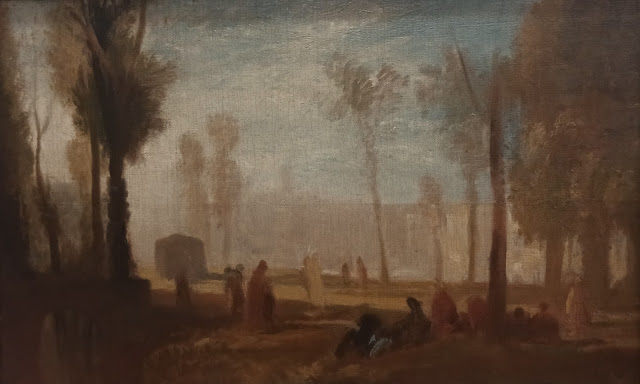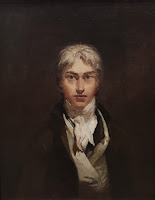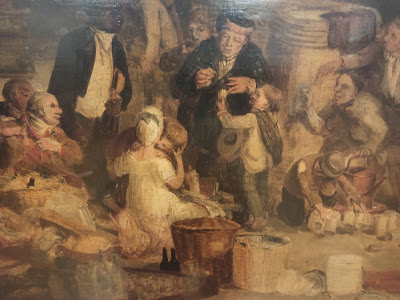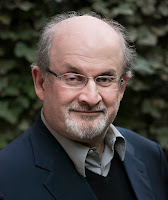For this review, and before plunging into various elements, I thought I’d begin with a brief precis; and then turn to three interesting issues. Firstly, I would like to discuss Margaret Atwood’s literary style. Then, I would like to critique two very interesting facets of the totalitarian in The Handmaid’s Tale; and then, lastly, weigh the novel’s standing as a dystopian fiction.
✲✲✲
Precis
This novel is set in the “near future”. Its protagonist, Offred, is a young “handmaid” who has been seized and corralled by the burgeoning theocratic regime. She is inculcated and reprogrammed with the regnant “ideology” of the androcratic theocracy. She is then designated the chattel of the “Commander” and his wife.
In this dystopia, as a result of war and toxicity levels, birth rates have dived perilously low. Viable offspring is the preeminent concern. Offred is valued for her ovaries. Everything else is mere ephemera that distracts her from that overriding ‘duty’. She is not allowed to read, wear make-up, or adorn herself in anything beyond monastic nun-like vestments. She is permitted to go shopping once-a-day but, otherwise, must bear the Commander a healthy new-born.
However, Offred wasn’t born into this regime. She preceded it. She has memories of former times as an independent woman with a job, husband and daughter. No indoctrination can allay her mind; her ability to retrieve images of happier times. But, that’s mere memory. Her present existence in the Republic of Gilead is fragile and fugacious. That is the world she must navigate.
✲✲✲
Literary style
Generally speaking, I quite enjoyed Atwood’s prose. Although, throughout the novel, via the first person, we are made to think that Offred ‘speaks’ to us. In reality, that voice is both Offred and Atwood. Atwood’s ability as a wordsmith is quite evident. However, there are occasional moments in which, for me, Atwood may be trying too hard to strike a profound philosophical note; though, as I say, these are mere occasional.
I do place a very high premium on a novelist’s aesthetic craft and decorative prose over-and-above traditional elements of the novel, such as the plot. So, I suspect ‘conventional’ readers may recoil at Atwood’s lack of ‘traditional’ punctuation conveying speech, or the occasional concatenation of short sentences in her descriptive prose, etc. A further criticism may be its bathos and its seemingly flimsy conventional beginning, middle and end.
These criticisms, though, must be weighed against the structure of the novel which is essentially a transcript of audio recordings. Since the oral recordings were essentially Offred’s nuncupative testament, it goes without saying that the vocal inflections and modulations of the human voice were not suited to being codified into traditional prose by Professor Pieixoto. The discursive manner of human discourse can’t be fully systematised into formal prose. Indeed, it is probably Atwood’s intention – through her words on the page – to share an insight into such a dystopian experience; as opposed to a conventional story.
As I mentioned, Atwood is a witty wordsmith. The following lines were interesting:
We are being looked at, assessed, whispered about; we can feel it, like tiny ants running on our bare skins.
Now there’s a space to be filled, in the too-warm air of my room, and a time also; a space-time, between here and now and there and then, punctuated by dinner. The arrival of the tray, carried up the stairs as if for an invalid. An invalid, one who has been invalidated. No valid passport. No exit.
Late afternoon, the sky hazy, the sunlight diffuse but heavy and everywhere, like bronze dust. I glide with Ofglen along the sidewalk; the pair of us, and in front of us another pair, and across the street another. We must look good from a distance: picturesque, like Dutch milkmaids on a wallpaper frieze, like a shelf full of period-costume ceramic salt and pepper shakers, like a flotilla of swans or anything that repeats itself with at least minimum grace and without variation. Soothing to the eye, the eyes, the Eyes, for that’s who this show is for. We’re off to the Prayvaganza, to demonstrate how obedient and pious we are.
The “ants running on our bare skin” is evocative. The shades of meaning in the term “invalid” attests to Atwood’s wit, and her similes are quite forceful. I think the “flotilla of swans” is a stirring suggestive contrast.
However, there are certain discordant lines in the novel that don’t quite mesh for me. The attempt is made to strike a profound philosophical note but which, for one reason or another, seem flat. I cite two examples:
The minimalist life. Pleasure is an egg. Blessings that can be counted, on the fingers of one hand. But possibly this is how I am expected to react. If I have an egg, what more can I want?
I appreciate that the veiled metaphor of an egg, which in the world of Gilead, relates to the singular primacy of philoprogeniture. But, this childbearing analogy – in the context of a breakfast at a table – is rendered otiose by the fact that Offred doesn’t really believe her Handmaid ‘purpose’ is her only source of pleasure. Offred strives to give birth as a matter of prudence and practicality as opposed to a sincere ideological commitment. The rhetorical question “what more can I want” can only resonate within the mind of a completely brainwashed Handmaid. But that is not Offred. She sees through the patriarchal fascist system and hasn’t fully imbibed its chilling precepts. She has her own mind. So, the above passage doesn’t quite seem to work with Offred and feels rather strained.
Additionally, later on, Offred says:
I keep on going with this sad and hungry and sordid, this limping and mutilated story, because after all I want you to hear it, as I will hear yours too if I ever get the chance, if I meet you or if you escape, in the future or in Heaven or in prison or underground, some other place. What they have in common is that they’re not here. By telling you anything at all I’m at least believing in you, I believe you’re there, I believe you into being. Because I’m telling you this story I will your existence. I tell, therefore you are.
This allusion to Descartes doesn’t seem to make any sense. In the novel, Offred has never evinced any consideration to philosophical debates. It doesn’t seem at all relevant. Indeed, the mere act of reading a novel wouldn’t necessarily imply anything.
✲✲✲
The totalitarian
There are many aspects of the novel which throb to the totalitarian rhythm. It’s replete with the usual signatures of fascism; the book burnings, control via a cashless society, mob panic and crowd psychology, hangings, schizoid personality, paranoia, and so on. However, in this review, I shall focus on two interesting elements.
In The Handmaid’s Tale, Aunt Lydia, in particular, repeatedly invokes an inspiring and utopian-esque vision of the future for women. For example, she says:
The women will live in harmony together, all in one family; you will be like daughters to them, and when the population level is up to scratch again we’ll no longer have to transfer you from one house to another because there will be enough to go round.
This rehearsal of the glorious sunlight future is an enduring aspect of such brutal regimes. It’s also prevalent in Orwell’s dystopian novels (which I plan to review in due course).
For me, the above quote underlies a sense of pathos. In the French Revolution, the most poignant observation by Robespierre related to the question of what it would take to accomplish the Revolution’s utmost aim of a virtuous society. In his private notations in his “Catechism”, he realised that the revolution was never going to succeed. Even at the outset of his leadership of the Committee of Public Safety, his realisation was that the struggle itself was never going to burgeon the Jacobin promised land. In other words, the struggle itself was perpetual. It was interminable. The struggle was its own end. The excerpted passage below contains the essential aspects of Robespierre’s catechism to that effect;
What is our aim?
It is the use of the Constitution for the benefit of the people.
[...]
The people – what other obstacle is there to their instruction?
Their destitution.
When then will the people be educated?
When they have enough bread to eat, when the rich and the government stop bribing treacherous pens and tongues to deceive them, and instead identify their own interests with those of the people.
When will this be?
Never.
In The Handmaid’s Tale, Aunt Lydia’s invocation of the revolution’s ‘noble’ ends is merely the insecurity of the revolution. It’s her attempt to wrestle with the horrifying knowledge that it’s all for absolutely nothing.
✲✲✲
Another interesting aspect of totalitarianism is the role of history and memory.
In George Orwell’s 1984, there is a long wistful discussion between Winston Smith and a ‘prole’ at a pub. In the passage excerpted below, Winston Smith is agonising over acquiring some handle over history, a grip over the truth;
‘You are very much older than I am,’ said Winston. ‘You must have been a grown man before I was born. You can remember what it was like in the old days, before the Revolution. People of my age don’t really know anything about those times. We can only read about them in books, and what it says in the books may not be true. I should like your opinion on that. The history books say that life before the Revolution was completely different from what it is now. There was the most terrible oppression, injustice, poverty worse than anything we can imagine. Here in London, the great mass of the people never had enough to eat from birth to death. Half of them hadn’t even boots on their feet. They worked twelve hours a day, they left school at nine, they slept ten in a room. And at the same time there were a very few people, only a few thousands -- the capitalists, they were called -- who were rich and powerful. They owned everything that there was to own. They lived in great gorgeous houses with thirty servants, they rode about in motor-cars and four-horse carriages, they drank champagne, they wore top hats’
In The Handmaid’s Tale, as Offred watches a marriage ceremony, she laments the approaching eclipse of tangible memories and perspective. She says:
The marriages are of course arranged. These girls haven’t been allowed to be alone with a man for years; for however many years we’ve all been doing this. Are they old enough to remember anything of the time before, playing baseball, in jeans and sneakers, riding their bicycles? Reading books, all by themselves? Even though some of them are no more than fourteen – start them soon is the policy, there’s not a moment to be lost – still they’ll remember. And the ones after them will, for three or four or five years; but after that they won’t.
In a nutshell, having a sense of history and a cultural repository of memory empowers people. It endows society with a sense of perspective. It gives a frame of reference to compare and contrast. It accords a kind of intuition – an Aanschauung, as Germans would say – about the world and the regime.
I intend to exhaust this subject in a forthcoming post on 1984; but, presently, and briefly, I think my generation has suffered a significant deterioration in general historical awareness and understanding. Speaking from personal observation, I have noticed an almost generational decline in the awareness of Britain’s broader historical context and tradition. As an example, the kind of rich cultural and historical knowledge that my own grandparents had was deep and striking. They knew a lot more about a plethora of cities, dates, peoples, countries, battles; and all without wikipedia. It really puts my generation to shame.
According to Niall Ferguson, in surveys among university history students, they couldn’t name a single 19th century British Prime Minister; or that school leavers were unable to name the British Monarch during the Spanish Armada. Recently, I read that two-thirds of millennials were unaware of what Auschwitz was! (Washington Post)
This historical ignorance must be linked to a sense of cultural and political disintegration. Such societies must be ripe for totalitarianism because they have no sense of historical direction or perspective. Of course, we are not that bad; but it is worth noting that Orwell was inspired by his experiences in the Spanish Civil War. Stalinist communists would be re-writing historical events for their propaganda and planting untrue accounts claiming credit for other loyalist forces. Indeed, Stalin was quite famous for having ‘eliminated’ various figures from historical narratives.
As illustrated in The Handmaid’s Tale, without a resilient understanding of our traditional liberties and heritage, tyrants would be able to rewrite the past to shape the future.
✲✲✲
Dystopia or science fiction
When people wade through a dystopian novel, I think they read with a view of comparing the dejected cheerless two-dimensional environs of the literary landscape against the tangible and palpable real-world around us.
To my mind, Atwood’s novel unfurls a critical problem inherent in dystopian fiction. The problem is not the sheer extremity or the total barking madness of the totalitarian. It is that we never grasp how we have come to be nested in such a howling barren wilderness.
In The Handmaid’s Tale, the broader social commentary pivots on the intimate and personal account of Offred. The horrors of her world is her proximate reality, and, to that extent, we are deprived of much deeper and more multifarious layers of perception and understanding. For example, all the broader dimensions of The Republic of Gilead emerge from Offred’s discussions with the Commander; and these are sparse and terse. We are apprised of a military coup d’état, the execution of the President of the United States and most of the US Congress. Then, the Constitution was suspended. And that is more-or-less it, as regards the government.
The problem is that the attendant barbarism and inhumanity of totalitarian regimes do not emerge at once, or spontaneously, like a thunderbolt. They are marked by a series of gradual changes in society, bit-by-bit. This is illustrated in the ubiquitous, and thankfully apocryphal, metaphor of the boiling frog. It is said that if you lower a frog into a pot of boiling water, it will jump out immediately to escape. However, if placed in a pot of lukewarm or cool water but in which the temperature is slowly raised; it will boil to death.
Thus, if a dystopia is to serve a practical meaningful purpose, it must surely pose a reflective cultural mirror cautioning us: ‘this is a possible alternative reality’. As forceful and as didactic as Atwood’s reality is in illuminating the heart-sickening depravity and horror of evil governments and societies; we must have some idea as to how such waywardness came about. A dystopia is not merely an admonition; it’s a call to action.
Consider Adolf Hitler. He became leader of the Nazi Party which, at the outset, was just one of many radical German groupuscules that were ultra-nationalistic, anti-democratic with latent residual resentments and anger as regards Germany’s malaise and, especially, against Jews. Discounting pro tem Hitler’s Munich putsch, what is interesting is how gradually Hitler consolidated power within the Weimar government. He was never popular with the masses and lost the 1932 Reich Presidency vote to Paul von Hindenburg (Hitler’s much smaller tally of 36% against Hindenburg’s 53%). Hindenburg, for a multitude of misguided reasons, offered Hitler a Cabinet seat (reflecting the Reichstag’s Parliamentary system). Hitler refused cooperation and demanded nothing short of the Chancellorship. This risky strategy worked and Hitler was then appointed Chancellor in 1933. The following year, Hindenburg died, aged eighty-six; and, on that very day, Hitler fused the Chancellorship and the Presidency into a single authority: the Führer, within the machinery of government.
The above discussion doesn’t even broach the cultural antisemitism of the 19th century (coterminous with the Dreyfus affair in France, for example) and the Nazi party’s flammable antisemitism. So, as an illustration, there were ubiquitous rumours during WWI that German Jews within the military had eschewed battle and were even profiteering from it. So much so, the Prussian government carried out “Judenzählung” (“Jew count”) to establish the proportion of Jews to non-Jews on the frontlines. Afterwards, similarly, the “Dolchstosslegende” assigned moral blame for Germany’s defeat and subsequent humiliation on the ostensible disloyalty of Jewish Bolsheviks within German society.
In contrast, apropos The Handmaid’s Tale, we are never really told why, or how, this sulphuric level of cruelty and debasing inhumanity towards women ever emerged. It is simply taken for granted.
For example, what is the balanced reader supposed to think of the pathetic character of Luke, Offred’s erstwhile husband? He seems, at best, oblivious; and, at worst, tacitly acquiescent of the regime. When Offred’s mother seems to have disappeared and her home was burgled, he appears to coldly counter her impulse to call the police. Similarly, when Offred fumes over women’s loss of property rights and their inability to work, Luke placidly reassures her that he’ll “always take care of” her. Or the fact that he wishes to make love on the very day she lost her job. This, we are made to think, in the absence of any other context or explanation, is what Atwood intends to represent the average “well-intentioned” male. This is either comically ridiculous or utterly insulting to men who have both the faculty of empathy as well as mothers, aunts, girlfriends, wives and daughters on whom to empathise.
As I say, the broader problem in the dystopia – and to which I have alluded – is that one is expected to entertain the premise that our contemporary society actually view women as mere objects whose sole purpose is procreation and to which they may be regularly and ceremoniously raped. With pre-WWII Germany, there were pre-existing convulsions prior to the bitter recrudescence of antisemitism which accompanied the crash of 1929 and the reparations of Versailles. Not helped by the fact that, harking back to Renaissance Florence, Jewry had been associated with banking and money-lending (arising from prohibitions in the Old Testament against Christians charging usury on loans to other Christians).
In our world, in contrast, as Steven Pinker explained in The Better Angels of Our Nature, our postmodern society has been getting much better, with greater secularism, more humanism, greater emphasis on rights of minorities to which feminism has undergone several “waves”. Indeed, according to the Russel Sage, women have been outpacing men in education standards (Russel Sage Foundation). This is important because the education of women is inversely proportional to the childbearing fertility rates across the world. Thus, there is really no comparison with fascism and totalitarianism. Whereas, Jews had propaganda campaigns against them, curfews and travel restrictions imposed, required wearing of insignia of abasement, the boycott of Jewish-owned businesses etc… and that’s well before any Jews were sent to the camps.
Nevertheless, there is a presumed undertone that there are sufficient tracts of modern society where either ‘conservative’ or sufficiently religious (or some other presumably anti-abortion specimens) are endemically or inherently misogynistic. Furthermore, it is also presumed that these misogynists aren’t merely the grumbling lonely types: but are either actively or contentedly acquiescent in the imposition of barbaric slavery on womenfolk.
This may sound risible but that is more-or-less the contrived background which Atwood sets in her novel to make the plot and characters come alive. Since this novel is set, not in hundreds-of-years in the future, but within our own lifetime, I find it almost impossible to accept it as any dystopia.
✲✲✲
On a different note, the Commander’s rationalisation of the inhumanity and slavery of women – which is presumably reflective of the ideology of Gilead – is like listening to a mentally-deficient child complaining. It is completely devoid of any reason or perspective. I genuinely don’t quite understand what Atwood’s Commander’s grumble on womanhood is meant to convey. For example, at one point, he says:
The main problem was with the men. There was nothing for them anymore … There was nothing for them to do with women … I’m not talking about sex, he says. That was part of it, the sex was too easy. Anyone could just buy it. There was nothing to work for. We have the stats from that time. You know what they were complaining about the most? Inability to feel. Men were turning off on sex, even. They were turning off on marriage.
In the above passage, which is reflective of his general tone, the Commander contends that “there was nothing for them to do with women”. What on Earth is this supposed to mean? It’s like an eight-year-old child, arms crossed, grumpily declaring “I don’t like girls because they don’t want to play with me”.
We are not informed what he means when remarking that they had “nothing to do with women”? What about shopping? Going to the theatre? Playing games, like chess? Watching cinema films? Smiling and laughing together? Companionship? Friendship? Raising a family? Going to church? None of this is accounted for and this is problematic because the Commander does likes to chat, laugh and play games with Offred. So, clearly, he cannot genuinely endorse such a crude, reductionistic, and monochromatic view of women. Moreover, to the extent that the Commander may be justified; how does that even address or vindicate the tyranny? How does it account for the denial of human dignity, human liberty, freedom of conscience, the propagation of slavery, the death penalty, the ritualised ceremonial predation of rape, the gruesome “particicutions”, the banishing of “unwomen” to “colonies”, and all the various horrors of Gilead! It really doesn’t make any sense.
I think this detachment impedes the object of a dystopian novel which, as I mentioned earlier, is a call to action. It should rouse our sense of complacency. However, The Handmaid’s Tale feels remote from our contemporary reality. Thus, in spite of observed phenomena of group psychology and conformity, the idea that totalitarian slavery, abject misogyny and systematic rape would be visited on an entire continent out-of-thin-air leaves a hollowness at the heart of the dystopian novel.
.png)
.png)
.png)
.png)
.png)
.png)
.png)
.png)

.jpg)




































